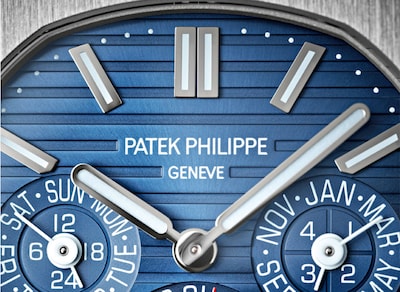Horological Complications: Part II
By Watches of Switzerland Group | 4 minute read

So you are thinking of purchasing a new watch – be it your first timepiece or a new addition to your growing horological collection, what functions do you need to consider? Is a minute repeater worth the extra cost? What exactly does a tourbillon do?
We know that setting your heart on a new watch can be a monumental task, so we’ve put together this guide to horological complications to help you understand their value. In part II of this guide, learn all you need to know about high-end complications such as moon-phase displays, minute repeaters and tourbillons.
Practical magic
While complications were all invented for a reason (even the whimsical moon-phase was developed to assist farmers who grow their crops according to the moon’s rhythms), today they are cherished more for the beauty and charm they add to a timepiece. Also, many of the higher complications add a considerable amount of value to your watch, making them smart investments. In this guide, we will share with you such complications: the ones that may not have any practical bearing on your everyday life, but will certainly add a little something to your luxury timepiece.
Ask for the moon: the moon-phase
Man has long been fascinated by the moon. For centuries, the skies were our clock, as our early ancestors used the sun, moon and stars to calculate time. Tracking the phases of the moon became our main method of measuring the months — and naming the days of the week (Monday is ‘moon day’). A complete lunar cycle takes 29 days, 12 hours, 44 minutes and 2.8 seconds, and there are four lunar phases: new moon, first quarter, full moon and last quarter. A moon-phase complication is a mechanism that displays the different phases of the moon as you see it in the sky each night, in an aperture on the dial of your watch.
Most moon-phase watches achieve this effect by using a disc illustrated with two identical moons, which sits behind the dial, often at 6 o’clock. With the disc advancing every day, one of the moons will move across the display over the course of 29 and a half days, with the ‘waxing’ and ‘waning’ faces of the moon shown using the curved edges of the dial aperture. As the lunar cycle completes, the other moon on the dial comes into view in the aperture. A moon-phase display is therefore a hugely charming and artistic complication, and one that is certainly a talking point.
Clear as a bell: the minute repeater
One of the oldest and most joyful complications is the minute repeater. This sophisticated mechanism chimes the time on demand and in different tones for hours, quarters and minutes when the wearer activates a push or slide-piece on the case. Its origin can be traced back to the so-called striking watches of the late 17th century. These ‘dumb’ repeaters struck the time on the inside of the case to produce a muted sound that could only be heard if the case was held closely to the ear.
Courtiers found these striking pocket watches to be especially useful, as they could discreetly check the time without offending the monarch. Soon, a bell was introduced for the hammer to strike and create a chiming sound. Minute repeaters first appeared in the mid-18th century before the widespread use of electricity, allowing the time to be heard in the dark, and were also used by the visually impaired. Abraham-Louis Breguet eventually dispensed with the bell by designing a complex mechanism that instead used a tiny and intricate set of coiled wire gongs to strike the hours, quarters and minutes in different tones. For example, the hours are usually signalled by a lower tone, the quarter-hours by a sequence of two tones, and the minutes by a high tone. Today, the minute repeater is a masterpiece of fine watchmaking, and is coveted by watch enthusiasts around the world.
Defying gravity: the tourbillon
Another desirable complication invented by watchmaker Abraham-Louis Breguet (arguably the grandfather of traditional fine watchmaking) is the tourbillon. It first appeared in 1795, when pocket watches were à la mode and wristwatches were still but a dream. Typically, pocket watches spent the whole day in one of two positions: vertical in a pocket, or horizontal on a table. Breguet found that gravity affected the balance wheel and delicate hairspring, thus rendering the pocket watch inaccurate over time. He therefore created a cage that could hold the vital components of the pocket watch mechanism, and would rotate through all possible vertical positions at a steady rate, preventing gravity from pulling on the hairspring. Translated from French, tourbillon means ‘whirlwind’, describing the way it rotates on its axis. This fascinating complication was long considered a rarity, but in recent years watchmakers such as Breguet and Patek Philippe have rediscovered its nostalgic beauty.
Practical magic
While complications were all invented for a reason (even the whimsical moon-phase was developed to assist farmers who grow their crops according to the moon’s rhythms), today they are cherished more for the beauty and charm they add to a timepiece. Also, many of the higher complications add a considerable amount of value to your watch, making them smart investments. In this guide, we will share with you such complications: the ones that may not have any practical bearing on your everyday life, but will certainly add a little something to your luxury timepiece.
Ask for the moon: the moon-phase
Man has long been fascinated by the moon. For centuries, the skies were our clock, as our early ancestors used the sun, moon and stars to calculate time. Tracking the phases of the moon became our main method of measuring the months — and naming the days of the week (Monday is ‘moon day’). A complete lunar cycle takes 29 days, 12 hours, 44 minutes and 2.8 seconds, and there are four lunar phases: new moon, first quarter, full moon and last quarter. A moon-phase complication is a mechanism that displays the different phases of the moon as you see it in the sky each night, in an aperture on the dial of your watch.
Most moon-phase watches achieve this effect by using a disc illustrated with two identical moons, which sits behind the dial, often at 6 o’clock. With the disc advancing every day, one of the moons will move across the display over the course of 29 and a half days, with the ‘waxing’ and ‘waning’ faces of the moon shown using the curved edges of the dial aperture. As the lunar cycle completes, the other moon on the dial comes into view in the aperture. A moon-phase display is therefore a hugely charming and artistic complication, and one that is certainly a talking point.
Clear as a bell: the minute repeater
One of the oldest and most joyful complications is the minute repeater. This sophisticated mechanism chimes the time on demand and in different tones for hours, quarters and minutes when the wearer activates a push or slide-piece on the case. Its origin can be traced back to the so-called striking watches of the late 17th century. These ‘dumb’ repeaters struck the time on the inside of the case to produce a muted sound that could only be heard if the case was held closely to the ear.
Courtiers found these striking pocket watches to be especially useful, as they could discreetly check the time without offending the monarch. Soon, a bell was introduced for the hammer to strike and create a chiming sound. Minute repeaters first appeared in the mid-18th century before the widespread use of electricity, allowing the time to be heard in the dark, and were also used by the visually impaired. Abraham-Louis Breguet eventually dispensed with the bell by designing a complex mechanism that instead used a tiny and intricate set of coiled wire gongs to strike the hours, quarters and minutes in different tones. For example, the hours are usually signalled by a lower tone, the quarter-hours by a sequence of two tones, and the minutes by a high tone. Today, the minute repeater is a masterpiece of fine watchmaking, and is coveted by watch enthusiasts around the world.
Defying gravity: the tourbillon
Another desirable complication invented by watchmaker Abraham-Louis Breguet (arguably the grandfather of traditional fine watchmaking) is the tourbillon. It first appeared in 1795, when pocket watches were à la mode and wristwatches were still but a dream. Typically, pocket watches spent the whole day in one of two positions: vertical in a pocket, or horizontal on a table. Breguet found that gravity affected the balance wheel and delicate hairspring, thus rendering the pocket watch inaccurate over time. He therefore created a cage that could hold the vital components of the pocket watch mechanism, and would rotate through all possible vertical positions at a steady rate, preventing gravity from pulling on the hairspring. Translated from French, tourbillon means ‘whirlwind’, describing the way it rotates on its axis. This fascinating complication was long considered a rarity, but in recent years watchmakers such as Breguet and Patek Philippe have rediscovered its nostalgic beauty.
